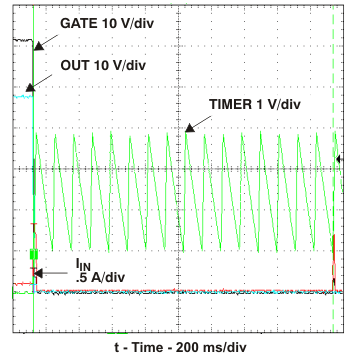JAJS177F November 2003 – February 2020 TPS2490 , TPS2491
PRODUCTION DATA.
- 1 特長
- 2 アプリケーション
- 3 概要
- 4 改訂履歴
- 5 Pin Configuration and Functions
- 6 Specifications
- 7 Detailed Description
- 8 Application and Implementation
- 9 Power Supply Recommendations
- 10Layout
- 11デバイスおよびドキュメントのサポート
- 12メカニカル、パッケージ、および注文情報
7.4.5 Automatic Restart (Figure 17)
The TPS2491 automatically initiates a restart after a fault has caused it to turn off Q1. Internal control circuits use CT to count 16 cycles before re-enabling Q1. This sequence repeats if the fault persists. The TIMER has a 1:10 charge-to-discharge current ratio, and uses a 1-V lower threshold. The fault-retry duty cycle specification quantifies this behavior. This small duty cycle often reduces the average short-circuit power dissipation to levels associated with normal operation and eliminates special thermal considerations for surviving a prolonged output short.
 Figure 17. TPS2491 Restart Cycle Timing
Figure 17. TPS2491 Restart Cycle Timing